- Home
- Amanda Hocking
Hollowland Page 23
Hollowland Read online
Page 23
She knows what will happen next – or at least has a vague notion. She has been trained since birth for the coming events. She knows her place and what she must do. But an empty feeling eats away at her gut just the same; a basin of loneliness and distrust that begs to be satisfied. The looks on the faces of those they pass by don’t help. Though she loves her people, she can’t help but feel disdain, as well. They stare at her with equal parts awe and fear, as if she is some odd and frightening creature that only just now landed in their midst. She feels alone and vulnerable, distant from their lives and futures, even though, as Teacher and Mother have told her, their future lies solely with her. It is a tedious incongruity she has to bear. But she doesn’t have to like it.
The family reaches the town’s boundary and they head across the dock. On either side of the wooden planks, people are busy readying the ships which rest there for launch. At the pier’s end her father stops and nods to the large, gruff man who stands at the helm of the lead vessel. The man’s own daughter stands next to him, four years the girl’s elder and her friend for as long as she can remember. Her hair is short, curly, and brown. The girl on the boat sighs and waves, trying to stretch her mouth into a smile, and this causes the other girl’s spirits to lift. There is no apprehension in her face as she clings to her father’s large arm, only hope and fear for her friend’s safety.
The big man turns to her father then raises his hand to those standing on the deck. Ropes are cast aside and sails lifted. The large man, the father of her best friend, offers her own father a salute with two fingers, which her father returns. He and his daughter begin to move away from them, flowing towards the mouth of the inlet. One after another, the boats drift into the open water in a sluggish procession of faith.
The girl with the red hair – Izzy, as her father calls her – stands with her parents and watches the people, their friends and neighbors and family, edge out of the bay. Her mother touches her arm lightly and leads her to the large cabin at the head of the pier. They enter and the girl spots Teacher, surrounded by a group of very nervous-looking men. She tries to grin at him, but the intensity on his face says this is not the time for niceties. Instead he touches his forehead with a single finger, a gesture her father returns, and barks at those within the cabin to disperse; which they do, and quickly, leaving behind a wake of dust and the echo of their footfalls. Teacher is the last to leave. He bites his lip as his eyes make contact with hers.
She has never seen Teacher scared. It isn’t a pretty sight.
They are finally alone. “Are you ready, Izzy?” her father asks her. She gazes at him and nods. He looks pained, frightened, and yet the compassion he gives her is palpable. She knows he loves her more than anything in the world, even Mother. All of which makes what he now has to sacrifice all the more disheartening.
“The lookout gave the signal,” he says. “There’re ships approaching from the other side of the island. Big ones. We have to go. It’s time.”
She leans forward and kisses him on the lips. When she pulls back she sees tears flooding his eyes. She wants to tell him not to worry, that all will be fine, but can’t. There are no guarantees for them any longer. This, she understands completely.
They exit the hut, this tight-knit family of three, and allow the rising sun to bathe them for what might be the last time. The girl closes her eyes and steps ahead of her parents, allowing the brisk wind to make puppet strings of her hair. She doesn’t know what the conclusion of all this will be, but she takes solace in the fact that, no matter the outcome, the nightmares will stop. The empty feeling in her gullet will disappear and the voices in her head will cease their chatter. In the end, she will be whole for the first time, or she will be dust.
Either way, this translates to peace.
Chapter 1
The Discovery
“What do you mean you’re not coming, James?”
“Sorry, Ken,” the man on the other end of the phone said. “Cynthia’s having contractions.”
Ken grunted. “Contractions? She’s not due for another month. It’s most likely false. Don’t go.”
“Sorry, bloke, but she wants me home, so our plan’s taken a bit of a diversion.”
“That’s just fantastic.”
“Again, I apologize, Ken. Listen, I’m at the airport right now. Flight’s getting ready to take off. I have to go.”
“Fine. Call me when you land. What’s that, nine hours from now?”
“I think.”
“So I should be done with the inspection by then.”
“You’re going ahead with it anyway?”
“Of course. I’m not going to miss the opportunity of a lifetime.”
“Very well. Be careful. And wish me luck.”
“Why?”
“The only flights to London I could get at such short notice land in Gatwick.”
Ken snapped his cell phone shut without laughing, wiped sweat from his forehead, and checked his watch. Nine o’clock in the morning and it had to be close to a hundred degrees already. Steam rose from the adobe buildings lining the dirt road. There were no adults to be found, but a great many children had gathered, playing stickball and eyeing him with suspicion. He definitely stood out in this impoverished sea of brown flesh, what with his lily-white skin, sandy blonde hair, and sweat-covered khaki shorts. He puffed out his cheeks and checked his watch again. Raul, the guide hired to bring he and James to the excavation site, was ten minutes late. The way people seemed to lack any respect for punctuality and the plans of others annoyed him more than anything, and that included associates who backed out of once-in-a-lifetime opportunities.
An archeologist by trade and cultural anthropologist by passion, Doctor Ken Trudeau funded his travels through the backing of Oxford and London’s Natural History Museum. He’d spent much of the past twenty-five years traversing the globe, hoping to further his understanding of cultures long lost to the rest of the civilized world. He scoured most every corner of Europe and Asia, and even spent a few years residing among the aboriginal tribes of New Guinea; living as one with them, drinking up their wealth of primal knowledge, and treating them not as subjects, but as brothers.
Yet despite all he’d seen, all he’d experienced, what lay ahead of him now was the culmination of a dream.
The ancient Mayans were Ken’s obsession, and had been for the majority of his fifty-one years. The sudden disappearance of their culture became the study that intrigued him most. With their virtually preternatural understanding of astronomy and the passage of time, which far exceeded the erudition of their contemporaries, it seemed unparalleled that they would suddenly up and vanish. What happened? Did famine overtake them? Disease? Did the rivers overrun and flood the land, leaving them no other choice but to scatter and integrate with surrounding cultures? To these queries Ken still found himself in the dark, waiting for someone to shine a beacon and draw him forward.
That beacon now shone with news of the excavation.
In an archetypal flash of irony, an underground fissure had been uncovered while the Honduran government blasted through the rainforest, their effort being to construct a new freeway that would lead to a soon-to-be-completed eastern waterway. After local scientists poked their noses around, it was discovered the chasm led to the interior of an ancient Mayan temple. A priceless piece of history, found during Man’s attempt to wipe the past from the face of the earth in the name of expansion.
The popular theory was that the temple had been swallowed by the earth in the aftermath of some great earthquake, but Ken didn’t care about the reasons for its existence. That it existed at all was all that mattered to him. It served as the possible answer to his dreams. He smiled at the thought.
A tan Jeep tore around the corner, almost striking the stickball-playing children. It careened into a fruit seller’s cart. Mangoes and oranges flew through the air, creating a barrage of juicy, round missiles that splattered upon impact. The man behind the wheel of the Jeep, apparently
unconscious of his driving, wore an expression on his face that reeked of youthful ineptitude. He waved at Ken with one hand and spun the wheel with the other. The automobile screeched to a halt at curbside, fifteen feet away.
“Hola, doctor,” the man, Raul, slurred when the vehicle stopped rocking. Ken approached it. Raul’s body odor stunk of liquor. “Where’s the other one?”
“You’re late,” Ken snapped, then said, “and it’s only me today.” He threw his bags over the headrest and climbed into the passenger seat. Raul started to ramble, offering an endless succession of excuses, but Ken stopped him with a wave of his hand.
“No bullshit, let’s just go,” he said. “I’m on a schedule here.”
* * *
The Jeep bucked and lurched as the tires struck the roots and vines that cluttered the thin layer of dirt that passed for a jungle road. Sweat covered Ken’s body and mosquitoes persisted to hover about his head despite the speed at which Raul drove. He itched all over and didn’t care. The inherent beauty of the rainforest moved any discomfort to the back of his mind. It seemed such a difficult proposition for people to live in conditions such as these. The humidity, the insects, the predators; all these natural dangers made one have to be on top of their game to simply survive, let alone blossom into a society. To Ken, this fact brimmed with splendor. It echoed the heights humans could reach – did reach – before technology caused universal laziness to wash over the globe.
Two hours after the journey began they entered a clearing. The vision of the site awoke a tinge of sadness within Ken; the soothing embrace of nature in its purest form was ripped away, revealing the ugly beginnings of Humanity’s pursuit of intended uniformity. Rubble from the excavation had been carelessly placed in random piles, creating a rocky maze so thin in some places that stone tore into the Jeep on both sides when they passed.
They drove across the winding stretch of flattened grass that weaved through the debris and stopped at what looked like a giant mouth cut into the landscape. Ken stepped out, pulled his travel case from the back, and removed from it his harness, a coil of thick cable as wide as his torso, and his tool belt. He took a clasp – one of each had been secured on opposite ends of the lead – and fastened it to the Jeep’s tow hitch. That done, he tossed the cord over the edge of the pit. A few seconds later he heard a dull thud. The cable had struck ground. He whistled between his teeth. Judging by how long it took to reach the bottom, it had to be at least seventy feet deep. A cold, nervous sweat dribbled down his neck as he fastened the tool belt around his waist, wiggled into the harness, locked its catch around the line, and put on his gloves. He crawled to the lip and peered over.
“Bugger, that’s deep,” he whispered. Then, his resolve returning, he turned to Raul and said, “You, wait here,” in an authoritative tone.
While bracing his feet on the rim of the crater he pulled the cable taut, took a deep breath, and plunged into the void.
A rush of cold, wet air greeted him. His arms ached as he lowered himself down one hand at a time; his leg muscles stiffened from squeezing his feet against the rope for support. Had James been there he would have used the second support lead, which he should have done anyway, just in case. Now, if he fell, there’d be nothing to break his fall but the ground below. He shivered and tried to force thoughts of his carelessness to the back of his mind, which proved a simple task seeing as his anticipation bubbled over any other invading emotion like foam at the crest of an ocean wave.
Still further he descended. No light penetrated the small opening up above, leaving him in the black. Barbs scraped his bare elbows when he swung too close to the cracked tunnel walls. He considered for a moment how the walls themselves seemed much too round, the plunge much too straight, to be the happenstance creation of wayward dynamite. He thought it possible the channel had been created, then pushed that thought, as well, to the storage space in the deep recesses of his brain. There will be no conjecture here, he thought. There is only observation. Gather the data. The time for assumptions and analysis comes later.
After fifteen minutes of his slow, laborious plunge through the darkness, he felt a sudden breeze. The mugginess surrounding him disappeared – the revealing sign of the end of the channel. He remembered the warning Fuad Cerrano, the director of the Nicaraguan National Institute, left on his cellular – take it slow once you hit the open, you will have the urge to drop quickly, don’t do that, the plummet is far, yet the floor still seems to come at you in a hurry, the first two men we sent down both broke bones in their legs – and he heeded that advice, placing one hand beneath the other even slower than before.
Amazingly, it took just as long for his toes to brush the ground as it had to enter the chamber from the tunnel. His feet rolled flat from ball to heel, steadying himself as if he’d spent the last year in zero gravity. He disengaged clamp from cable, took off his gloves, and felt for the line’s end. There it was, right at his fingertips, without having to be uncoiled; which meant the depth of this chasm was very close to the line’s full hundred feet. A whistle escaped his lips, pierced the silence around him, and bounced back two fold.
He grabbed the flashlight from its place in his belt and clicked it on. A blazing cone of yellow light cut a streak through the darkness. Ken looked around in amazement, trying to take in each thing the flashlight’s narrow beam revealed. He stood in the middle of a huge, square room – fifty or so feet from wall to wall by his best estimation. Hieroglyphs covered those walls for as far up as he could see. Six crudely built wooden tables stood against the wall he faced. He marched slowly toward one of them. A thick layer of white dust – Ken thought it most likely the granular remains of bones – covered the top of its flat slab. He pulled a brush and plastic bag from his belt and stepped forward, intent on sweeping in a sample for later testing. His foot struck a vagrant stone and he fell, barely getting his hands up in time to stop his face from striking the splintery edge of the table. He glanced up at the opening he’d come through, now just a speck in the middle of nothingness. Again that feeling of foolishness washed over him. He had to be careful.
He paced along the edge of the room, attempting to decipher some of the more interesting symbols. What he saw was both beautiful and terrifying; a tale of harmony and discord, birth and demise, life and death. A common theme Ken hadn’t seen before was interspersed between each set of pictograms – a single flame beside a primitively painted skull with no jaw. He tried to wrap his mind around the images. He’d seen pictograms such as these over the years, but they always seemed to flow smooth, always told a story. The invading skull and flame didn’t make sense.
That lack of logic shot a spike of enthusiasm up his spine. If there had been a Black Death here, or a period of religious cleansing like the Crusades, the messages printed on these walls might be the only record. This is the place, his feelings screamed, the answer, the missing piece of the puzzle!
With renewed vigor, Ken worked at a much faster pace. He turned where one wall met another and carried on much as before, eyeing his discovery with the nervous glee of a child at Christmas. His pace quickened again and he passed to the third wall, then the fourth. That was where he stopped.
An arched portal appeared in the middle of that fourth wall. It stood only five feet high. Ken bent and flashed his light in to get a look at what lay beyond.
It was a passageway, the same height as the portal which led to it. The barrier at the end of the tunnel looked to be made of a strange, milky substance, like a sponge. The walls leading down contained nothing as elegant as hieroglyphs; only smooth rock with nary a crack. It took a moment for Ken to realize that nowhere in the temple interior did he see so much as a seam. This place hadn’t been built with the customary adobe bricks. To the contrary; it seemed to have been borne from the earth itself.
The sound of clamor reached his ears and he aimed the flashlight at the floor of the tunnel, revealing a scurrying sea of insects. The bugs didn’t enter the main chamber, though there
was nothing to stop them; they simply clawed and scurried all over each other, as if to leave the safety of the passageway would bring an immediate end to their short lives. Ken let out a sigh. He could stand the proposition of squatting through the burrow with those things under his feet, but he hadn’t brought a change of pants or socks; which meant he’d most likely be stuck with their gummy innards all over him until they arrived back at the hotel. “Small sacrifice,” he whispered, then crouched beneath the stone arch. Insects crunched beneath his soles and he had to fight off the itch to purge his morning meal of poached eggs and blood sausage when they began crawling over his boots and up his leg. He held his breath and went on regardless. Nothing so little as a few bugs could stop him now.
The insect-and-dust-filled corridor ended after only twenty-two steps. The milky substance turned out to be thick tangles of spider webs. Ken brushed them aside, exposing the wall. His bit his lip hard enough to draw blood and stared into the eyes of a monster.
It was only a painting, though a very meticulous one, of a decaying man, hunched over and grinning with a lipless sneer. The care that went into creating this morbid work of art was astounding. He could clearly see the flesh hanging from its bones like frayed carpet fibers. Ken shivered and brushed away a centipede that had made its way to the nape of his neck before hunkering in to take a closer look. No detail had been spared; there were even fibers of exposed muscle that seemed to glisten in the flashlight’s beam. This is amazing, he thought. It’s so intricate. It belongs in the National Gallery, not the…
A final detail caught his eye, stopping him cold.
The monstrosity on the wall held a strap, made to look like leather, in its bony right hand. The strap itself attached to what at first resembled a pair of sunglasses until Ken realized what they actually were – the orbital bones from a human skull.

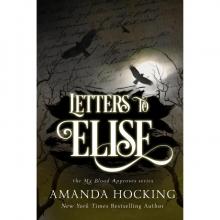 Letters to Elise: A Peter Townsend Novella
Letters to Elise: A Peter Townsend Novella Hollowmen
Hollowmen Swear
Swear Switched
Switched My Blood Approves
My Blood Approves Forgotten Lyrics
Forgotten Lyrics Frostfire
Frostfire Between the Blade and the Heart
Between the Blade and the Heart Wake
Wake Torn
Torn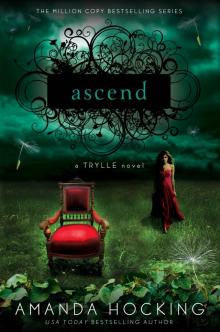 Ascend
Ascend Ice Kissed
Ice Kissed Hollowland
Hollowland Fate
Fate Elegy
Elegy Lullaby
Lullaby Wisdom
Wisdom Tidal
Tidal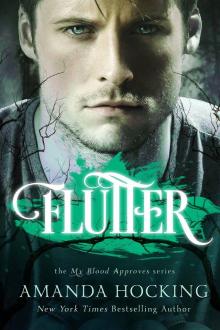 Flutter
Flutter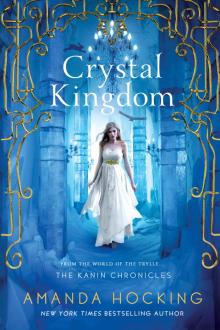 Crystal Kingdom
Crystal Kingdom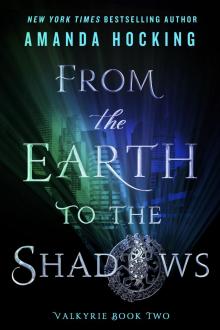 From the Earth to the Shadows
From the Earth to the Shadows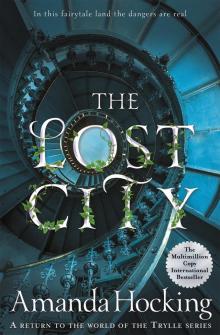 The Lost City
The Lost City The Morning Flower
The Morning Flower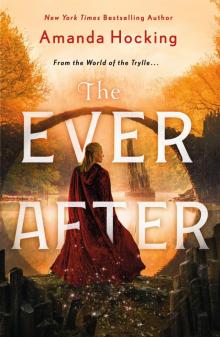 The Ever After
The Ever After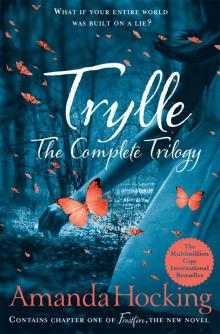 Trylle
Trylle Watersong03 - Tidal
Watersong03 - Tidal Wisdom (My Blood Approves series)
Wisdom (My Blood Approves series) Virtue - a Fairy Tale
Virtue - a Fairy Tale Elegy (Watersong #4)
Elegy (Watersong #4)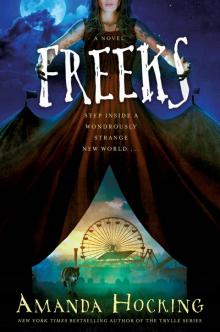 Freeks
Freeks Forgotten Lyrics: A Watersong Story (A Watersong Novel)
Forgotten Lyrics: A Watersong Story (A Watersong Novel) Swear (My Blood Approves #5)
Swear (My Blood Approves #5) Ice Kissed (The Kanin Chronicles)
Ice Kissed (The Kanin Chronicles) My Blood Approves mba-1
My Blood Approves mba-1 Forgotten Lyrics: A Watersong Story
Forgotten Lyrics: A Watersong Story Lullaby (A Watersong Novel)
Lullaby (A Watersong Novel) Wake (Watersong Novels)
Wake (Watersong Novels) Elegy w-4
Elegy w-4